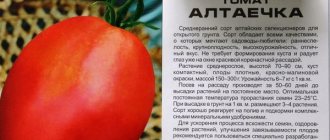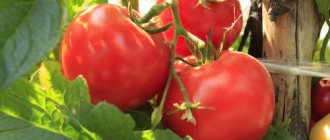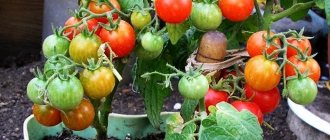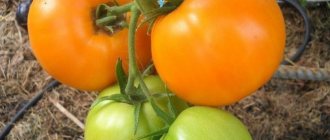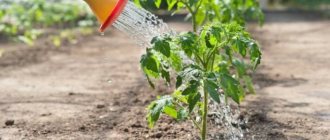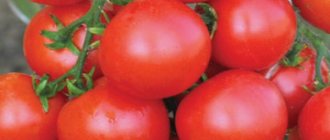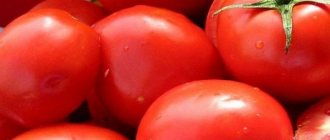Many gardeners have been growing tomatoes for many years and have managed to create their own collection of favorite varieties that will not let them down in any situation. Others are just starting their garden life and are trying, based on other people’s experience, to assess how suitable this or that variety of tomatoes is for them.
The Kibitz tomato can interest both the former and the latter, since it has many attractive properties and characteristics, and beginners in gardening will be especially pleased with its stability and unpretentiousness in cultivation.
Description of Kibitz tomatoes
The history of the creation of the Kibitz tomato is unknown, since reliable data about it does not exist. Seed material enters Russia mainly from Ukraine, so there is a version that this species was bred there or in neighboring Poland.
In view of this, Kibits is not included in the State Register, and it is impossible to find it in the assortment of domestic seed companies.
The Kibitz tomato has limited bush growth, as it is one of the determinate species. The maximum plant height is 60-70 cm in open ground, and 80-100 cm in a greenhouse or greenhouse. The bush is spreading, with 3-4 main shoots. The plant should be shaped. It needs additional support, since when numerous tomatoes ripen, the stems bend toward the ground under load, which can negatively affect the presentation.
Important! The Kibitz tomato can be grown in greenhouses, greenhouses, and open ground.
The leaves of this species have a standard shape, medium size, and a dark green hue. The first flower brush is formed above the 4-5th leaf, and each subsequent one is formed after three. They grow 5-7 tomatoes. The peduncle is articulated.
Tomato Kibits is a mid-early variety. Tomato ripening occurs 100-110 days after germination.
Brief information about the variety
- Fruits and bush: small tomatoes, the weight of one fruit is 60-80 g, the skin color is bright red, the flesh is dense, aromatic, with noticeable sourness; The bush is determinate, reaches 50-70 cm in height, with medium foliage.
- Productivity: high indicators - 3-5 kg of fruits are collected from one bush.
- Resistance: the species is resistant to late blight, gray rot, as well as to the parasite nematode. During the period of activity of viral diseases of tomatoes, preventive treatments are required.
- Distribution: throughout Russia - in warm regions (Rostov, Astrakhan, Volgograd) it is allowed to grow the variety in beds; in cold regions (Siberia, the Urals, Altai) exclusively the greenhouse method is used.
- Application: universal - vegetables are consumed fresh, canned, dried, dried.
- Planting: seeds are sown in March, seedlings are transferred to beds at the age of 50-60 days; use the seedling method; The recommended scheme is 5-6 bushes per 1 m².
- Soil: fertile, light, loamy.
- Care: the crop does not require pinching and bush formation; it requires regular fertilizing, watering, and loosening the soil; It is advisable to tie up the bush.
- Ripening period: the first fruits ripen 85-105 days after sowing the seeds. Tomatoes can be stored for about a month.
Description of fruits
Kibitz tomatoes have an elongated oval shape. They are all about the same size. The weight of tomatoes is 60-70 g. Initially, tomatoes have a light green tint with a large dark spot in the area of the stalk. When ripe they acquire a uniform red color. The pulp is fleshy, sweet, with slight sourness. Inside there are small seed chambers - 2 pieces each. in every tomato. The fruits have a rich tomato aroma.
When fully ripe, the fruits begin to fall off, so harvesting must be done in a timely manner. Kibitz tomatoes have dense, thin skin and medium-consistency pulp. These qualities contribute to long-term storage of the crop and also allow it to be transported without loss of presentation.
Important! As they grow, Kibitz tomatoes are blunt-nosed, but when ripe they develop a sharp tip.
Tomato has a stable yield
Characteristics of tomatoes
Some people classify the fruits of this variety of tomatoes as pepper-shaped tomatoes, others as cream tomatoes, however, its general characteristics can be described as follows:
- The shape of tomatoes is elongated with a characteristic spout at the tip of the fruit.
- The size of the fruits is average, they reach 10-12 cm in length, the average weight of one fruit is 60-80 grams.
- At the stage of technical maturity, tomatoes are green, then they turn brown and acquire an orange tint, and when fully ripe they are bright red. There is no dark spot near the stalk.
- The fruits have 2-3 seed chambers.
- The pulp of Kibitz tomatoes is dense, fleshy, even sugary at the break. The skin is smooth, quite dense and durable.
- Taste qualities are rated a solid four. Some people think that the taste is very good, especially for early ripening tomatoes. Others use Kibitz tomatoes exclusively for preparations. At least tomatoes cannot be called sour; they contain a sufficient amount of sugar.
- The use of tomatoes is universal. And although most housewives consider this variety ideal for whole-fruit canning, others use Kibitz tomatoes exclusively for drying and drying. Indeed, since fruits have a high content of dry matter, excess moisture evaporates from them very easily.
- Tomatoes of this variety are also distinguished by the possibility of long-term storage. In suitable cool conditions they can be stored without loss of presentation for about a month. Kibitz tomatoes also have no problems with transportation.
Characteristics of the Kibitz tomato
Every gardener wants to get the maximum yield when growing a particular variety. Therefore, in order to understand what results can be expected when cultivating the Kibitz tomato, you need to study its main characteristics.
Kibitz tomato yield and fruiting
Kibitz tomatoes ripen in late July - early August, depending on the growing region. The yield per plant in open and closed ground is 3.5 kg, which means that from 1 sq. m you can harvest up to 14 kg of tomatoes. This variety easily tolerates dense plantings. At the same time, its productivity does not decrease.
But the ovary of this species does not depend on weather conditions. And even with significant cooling, the plant does not shed its flowers.
Important! Kibitz tomatoes are not prone to cracking even in high humidity conditions.
Area of application of fruits
The Kibits variety is universal. Tomatoes can be eaten fresh or processed. Due to their small size, they can be used for whole-fruit canning, pickling and pickling. Kibitz tomatoes are also suitable for salads where sliced pieces are needed. During the cooking process, the pulp retains its structure and taste.
Kibits tomatoes can be dried and dried, and also used for juice, paste, sauce, lecho.
Resistance to diseases and pests
Tomato Kibitz shows increased resistance to common crop diseases. But in rainy, cool summers it may suffer from late blight. Therefore, for preventive purposes, bushes should be sprayed with fungicides to preserve the harvest.
This species can also suffer from the Colorado potato beetle when planting seedlings in open ground and from whitefly in a greenhouse. Therefore, when the first signs of damage appear, it is necessary to take protective measures.
Diseases and pests
The Kibitz tomato variety has increased resistance to common diseases and the negative effects of pests. If the plants are provided with proper care and the weather conditions are favorable, then they will not be afraid of any diseases throughout the season.
Occasionally, a tomato bush is affected by the following pests:
- caterpillars;
- spider mite;
- nematodes.
When the first signs of their presence are detected, it is necessary to remove the diseased plant from the garden bed, and then treat the soil around it. For this, an infusion of onion and garlic peels is used. To prepare it, take 200 g of herbal remedy, add 1 liter of water and let it brew thoroughly.
Advantages and disadvantages of the variety
The Kibitz tomato, like other types, has certain pros and cons. And in order to appreciate this variety, you need to study them in advance.
In some catalogs the tomato can be found under the name Chibis
pros
- friendly ripening of fruits;
- versatility of use;
- early maturation;
- low maintenance;
- stable yield;
- suitability for long-term storage and transportation;
- excellent presentation;
- increased resistance to diseases;
- does not suffer from changes in temperature or humidity.
Minuses
- inferior in taste to salad varieties;
- When ripe, the fruits fall off.
Similar varieties
As already mentioned, you can only get Kibitz tomato seeds from collectors. But gardeners should not be upset, since there are several varieties that have similar characteristics. These include:
- Cascade;
- Royal Temptation F1;
- Shuttle;
- Rocket;
- tomato Auria (or Manhood);
- Casanova;
- Khokhloma;
- Tomato Roma.
Features of cultivation
It is necessary to grow the Kibitz tomato in seedlings. By the time the seedlings are transplanted to a permanent place, their age should be 55-60 days. Therefore, sowing should be done in early or mid-March.
For planting, you need to prepare a nutritious soil mixture of turf, sand, humus and leaf soil in a ratio of 2:1:1:1. Disinfection should also be carried out. To do this, soak the seeds in a weak solution of potassium permanganate for 15 minutes. Then rinse with clean water and dry until fluffy.
The substrate also needs to be disinfected. To do this, it should be poured with the same solution of potassium permanganate and dried. When planting, you should use wide containers with a height of 10-12 cm, with holes for removing excess moisture. They should be filled with soil, watered, and the surface leveled. Place the seeds at a distance of 2 cm from each other, sprinkle with a layer of soil - 0.5 cm, moisten with a spray bottle.
After planting, the containers should be covered with film and then placed in a dark place with a temperature of +24-+25 degrees. When sprouts appear, the containers should be moved to the windowsill and the maintenance mode should be lowered to +20 degrees. When two true leaves appear, plant the plants in separate cups, and after two weeks feed them with mineral fertilizer for seedlings.
You can plant seedlings in a permanent place in a greenhouse in early May, if the ground has warmed up to +15-+18 degrees, and in open ground - at the end of this month or early June. For 1 sq. m need to place six plants.
Important! When transplanting to a permanent place, the seedlings should be buried down to the first pair of leaves, which promotes the development of a powerful root system.
Watering Kibitz tomatoes should be done as the top layer of soil dries. To do this, it is better to use settled water at a temperature of +18 degrees. Also, caring for the variety involves regular fertilizing. For the first time, you should use mullein 1:10 or chicken manure 1:15 while growing green mass. Then you need to switch to mineral fertilizers: superphosphate (40 g) and potassium sulfide (30 g) per bucket of water. They need to be applied during flowering and fruit formation.
In hot summer conditions, the soil at the base of the bushes should be mulched with peat or humus to reduce moisture evaporation.
Errors during cultivation
Caring for tomatoes is not a difficult task, but many people make a number of mistakes. The most common ones are:
- poor-quality preparation of seed and soil;
- violation of the rules of agricultural technology when transplanting seedlings;
- irrational watering of beds;
- untimely application of fertilizers.
One common mistake is watering young plants too much. Tomato is a moderately moisture-loving crop. Each young plant does not require more than 2-3 liters per watering. Abundant watering washes nitrogen from the upper layers of the soil into the depths, as a result of which it becomes unavailable to plant roots. Probably many people themselves have noticed that those plants that are watered abundantly have a pale green color - this is an indicator of a lack of nitrogen. And tomato plants with moderate watering are distinguished by a dark green color of stems and leaves.
Pest and disease control
Despite the increased resistance of the Kibitz tomato to diseases, it is necessary to apply preventive treatment of bushes against late blight. It should be started two weeks after transplantation to a permanent place, and repeated every 14 days.
The following fungicides should be used for treatment:
- "Ridomil Gold";
- "Quadris"";
- "Hom."
Important! When repeating treatments, the drugs must be alternated.
To protect against the Colorado potato beetle and whitefly, Kibitz tomatoes should be sprayed with Confidor Extra working solution before planting in open ground. And repeat processing if necessary.
How to grow seedlings yourself?
Seeds are planted in the ground in mid-March if the gardener decides to plant the resulting bushes in a greenhouse.
If the farmer does not have a greenhouse block, seeds for seedlings are planted in the first ten days or mid-April. Before planting the seed, it is treated with potassium permanganate. The soil in the garden bed is also sprayed with a weak solution of potassium permanganate. After the sprouts appear (after 5-8 days) and 2-3 leaves appear on them, the plants dive. When the seedlings grow up, they need to be transplanted to a permanent place. If there is a greenhouse, this operation is carried out in mid-May, and bushes are planted in an open area in the first ten days of June.
Holes 8 cm deep are made in the beds, humus mixed with complex fertilizers and sand is added to them. After planting, the soil around the bushes is mulched. It is better to plant tomatoes in those beds where cucumbers or parsley grew before. Tomatoes grow well on the site of former cauliflower or carrot crops.
The planting pattern is 0.5x0.5 or 0.3x0.5 m. There is no need to tie up the bushes or remove side shoots from them. Sometimes, when a large number of fruits develop, it is necessary to install supports under the branches of the hybrid.
Tomato Chibis - a stable harvest without much hassle
What tomatoes could be named after the perky lapwing bird? Of course, they are short, with medium-sized fruits and unpretentious to grow. The shape of the fruits of this variety is elongated, pepper-shaped with a sharp beak-like nose. Small and dense tomatoes are great for canning, barrel pickling and cooking in their own juice.
History of growing Chibis tomato
Gardeners have been familiar with Chibis tomatoes for more than ten years. The variety was registered in the State Register in 2007 with permission for cultivation in all regions of the country. The application for state variety testing was submitted jointly by V.I. Kozak, Candidate of Agricultural Sciences, and Moscow Agro, which specializes in the sale of proprietary seeds.
Lapwing has gained fame as one of the best tomatoes for whole-fruit canning. It attracts not only its fruits that are ideal for pickling, but also its simple agricultural technology. Bushes can be grown without pinching or staking, without fear of fungal diseases.
Chibis tomatoes bear fruit well without staking or pinching
On forums, some gardeners compare Chibis with the Kibits tomato, which is common in Ukraine. Indeed, the varieties are similar, but there are also differences, for example, Kibits is earlier, non-seedling, and its bush is more compact.
Tomatoes Kibits and Chibis are similar, but still differ in some characteristics
Description of the variety and photo of the fruits
Chibis seeds are available for free sale under the brands “Gavrish”, “Sedek”, “Aelita”. These manufacturers give the tomato the following description:
- According to the ripening period, it is mid-season and mid-early; 100–110 days pass from the emergence of seedlings to the ripening of the first fruits.
- The bush is low, with limited growth, 50–60 cm in height.
- The fruits are elongated, cylindrical, with a spout, bright red, weighing 50–70 g. The tomatoes are very dense, do not crack, contain a lot of dry matter, and have a rich tomato taste.
A characteristic feature of the Lapwing is the sharp nose at the top of the fruit.
The yield declared by “Gavrish” is 3 kg per bush, but for this the fruits must be collected in the wild and ripened at home.
Characteristics of the Chibis tomato from the State Register of Breeding Achievements (table)
| Place of cultivation | open ground and under film covers on private farms |
| Purpose | salad and for whole-fruit canning |
| According to ripening period | mid-early |
| Bush | determinant |
| Sheet | green, medium size |
| Inflorescence | simple |
| peduncle | with articulation |
| Fetus | cylindrical, slightly ribbed, dense, red when fully ripe |
| Number of seed chambers | 2–3 |
| Weight of one fruit | 50–55 g |
| Taste | good |
| Productivity | 2.1 kg/m2 |
| Immunity | to crown and root rot |
Features of cultivation
Sow Lapwing tomato seeds in the last ten days of March, the deadline is early April. During the seedling period, care is standard: picking, watering, fertilizing and hardening before planting in a permanent place. Plant seedlings in open ground at the time when all return frosts have passed, and in a greenhouse and under temporary shelter - 1-2 weeks earlier.
Video: details about caring for tomato seedlings
The layout of Lapwing tomatoes in the garden is 40x60 cm. Care consists of abundant watering once a week in the absence of rain, loosening and fertilizing every 10–14 days with complex mixtures for tomatoes. The bushes do not need to be tied up or pinched. Chibis tomatoes have dense skin and, even lying on the ground, are not damaged by rot. With such minimal care there will be a lot of fruits, but small ones - about 50 g.
If you have time for formation and garter, then you can grow tomatoes almost 1.5 times larger - 70 g each. Remove all the stepsons below the first cluster, do not touch the rest, it is on them that the main harvest is formed in low-growing varieties. After such partial pinching, the bushes, which previously rested on the lower shoots, lose stability and fall to one side, so they will also have to be provided with support.
If you partially remove the shoots and tie up the bushes, the tomatoes will grow larger
The Lapwing harvest ripens in July - August. Ripe tomatoes can hang on the bushes for a long time without cracking. But if you collect them at the beginning of coloring, then the bush will have the strength to form new ovaries, and you will collect more fruits.
I think that medium-sized and dense Chibis tomatoes are perfect not only for salads and canning, but also for drying. I cut these tomatoes into 2-3 slices, remove juice and seeds with a spoon, sprinkle with chopped garlic or herbs and put them in the dryer. I store dried but still flexible slices in glass jars, filled with vegetable oil. It turns out to be a delicacy that can be eaten simply or added to various dishes as a spice. By the way, the oil is also imbued with aromas and perfectly complements any salads.
Tomato Krivyansky - description and characteristics of the variety
This tomato belongs to the early ripening hybrid type. The period of full ripening from planting seedlings to harvesting fruits reaches 95 days. The maximum height of the plant is 120 cm; after reaching the desired height, growth stops.
The stems are powerful and thick. The plant is characterized by a developed rhizome. This feature greatly distinguishes this variety from other hybrids. With such a trunk and roots, the Krivyansky tomato is able to withstand high temperatures for quite a long time. In hot weather and little rainfall, it gets enough moisture stored in the rhizome.
The leaves are dark green and medium in size. It is noteworthy that the bushes have a pleasant spicy aroma.
Distinctive features of tomato fruits
The pulp of the fruit is dense, juicy and has a bright tomato aroma. The skin is dense, which contributes to long-term storage, resistance to mechanical damage and transportation.
The Krivyansky tomato compares favorably with other hybrids in its ability to tolerate unfavorable conditions for growth. Practically not exposed to various types of diseases. Not a bad yield - about 19-20 kg of tomatoes can be harvested per square meter.
Recommendations for cultivation
This variety is grown by seedlings. Planting is greatly simplified by the fact that pre-planting seed treatment is not required, since all work has already been carried out by the manufacturer.
For planting, it is recommended to choose days in late March - early April. For each region, the choice of planting time must be approached individually, since growth and yield depend on natural conditions.
A distinctive feature of seeds is the complete germination of seedlings. In warm regions, planting occurs earlier, as the soil warms up faster
If seedlings are planted in a greenhouse, then it does not matter which region is chosen for planting
After sprouting, 60 days later you can plant tomatoes in the ground. If tomatoes are planted in open ground, then it must be processed. Fertilizers such as peat, ash, coal or other organic mixtures are suitable for this. Tomatoes grow well in greenhouse conditions
For growth in a warm room, mandatory ventilation is recommended, and it is important to avoid drafts
Before planting, it is recommended to pour a solution of potassium permanganate into each hole, which will help protect the roots from rodents and insects. It is very good if other root crops grew in this place the year before: carrots, parsley, cauliflower or zucchini.
The planting pattern may look something like this: 50 by 40, 40 by 40. Thus, approximately 8-9 bushes are placed on 1 square meter. The distance between sprouts should reach 40-50 cm, and the distance between rows should be 40 centimeters.
The plant must be tied up, as the branches cannot support the weight of the fruit and break easily. Throughout the season, monthly fertilizing is required; if this rule is not followed, this may negatively affect the yield. Fertilizers need to be alternated: chemical and organic.
Marina, 33 years old:
Since we live in the south of the country, it is quite difficult to grow tomatoes in high temperatures; we have to water the bushes regularly. Because of this, we chose the Krivyansky tomato. This variety easily survives such natural disasters. Productivity is high. The tomatoes themselves are very tasty and are great for pickling. The children in the family eat them straight from the bushes.
Viktorovna, 45 years old:
I didn’t decide to buy for a long time, but after the recommendations of my neighbors, I made up my mind. For several years now, these are the only tomatoes I have grown. Tasty and juicy they ripen very quickly. It is very difficult to choose the ideal option for our difficult climatic conditions. The Krivyansky tomato, in my opinion, is exactly the variety that satisfies absolutely all the requirements.
Denya, 43 years old:
The tomatoes are not very large, but juicy and sweet. Our family really likes this variety; for the last few years I have been growing only it. Every time, salted tomatoes are eaten with a bang; there is a lot of pulp in each fruit, so it is ideal for marinades and pickling. The juice turns out very tasty - rich and thick. I strongly recommend trying to plant this variety in your dacha.
